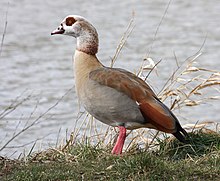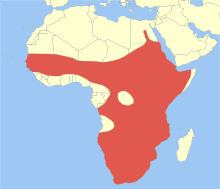Egyptian goose
| Egyptian goose | |
|---|---|

| |
Masai Mara Game Reserve , Kenya | |
| Scientific classification | |
| Domain: | Eukaryota |
| Kingdom: | Animalia |
| Phylum: | Chordata |
| Class: | Aves |
| Order: | Anseriformes |
| Family: | Anatidae |
| Genus: | Alopochen |
| Species: | A. aegyptiaca
|
| Binomial name | |
| Alopochen aegyptiaca (Linnaeus, 1766)
| |

| |
| Native range of A. aegyptiaca | |
| Synonyms | |
|
Anas aegyptiaca Linnaeus, 1766 | |
The Egyptian goose (Alopochen aegyptiaca) is an African member of the
Taxonomy
The Egyptian goose is believed to be most closely related to the
Etymology
The generic name Alopochen (literally, fox-goose) is based on Greek ἀλωπός (alōpós, also ἀλώπηξ alōpēx), "fox", and χήν (chēn) "goose", referring to the ruddy colour of its back. The word χήν : chēn is grammatically of either masculine or feminine gender.
The species name aegyptiacus (or aegyptiaca) is from the Latin Aegyptiacus, "Egyptian".[7]
Description

It swims well and appears heavy in flight, more like a goose than a duck, hence the English name.[8] On average, they are 63–73 cm (25–29 in) tall.
The sexes of this species are identical in plumage but the males are usually somewhat larger. They vary greatly in plumage tone, with some birds greyer and others browner, but this variation has not been observed to be sex- or age-related. A large part of the wings of mature birds is white, but the white is hidden by the wing coverts when at rest. When it is aroused, either in alarm or aggression, the white is displayed.[9]
Egyptian geese in the wild can live for up to 15 years, while captive individuals have been recorded reaching an age of 35.[10]
The voices and vocalisations of the sexes differ, the male having a hoarse, subdued duck-like quack which seldom sounds unless it is aroused, as well as a louder, breathy call which is performed in a rapid sequence, sounding somewhat like a steam engine.[11] The female has a far noisier raucous quack that frequently sounds in aggression when tending her young.[12] The male Egyptian goose attracts its mate with an elaborate, noisy courtship display that includes honking, neck stretching and feather displays.[13]
Distribution
The Egyptian goose is native to
It was found in southeastern Europe (up to the lower
Introduced populations
United Kingdom
The British populations of the Egyptian goose date back to the 17th century when it was introduced to estates and parks,[4][17] though the species was only formally added to the British bird list in 1971.[18] The British introductions were the first outside its native range; however, these individuals did not spread widely and are not known to have expanded into other countries.[4][17] In Great Britain, it is found mainly in East Anglia, and in various locations along the River Thames,[19][20] where it breeds at sites with open water, short grass and suitable nesting locations (either islands, holes in old trees or amongst epicormic shoots on old trees). During the winter, they are widely dispersed within river valleys, where they feed on short grass and cereals.[21][22] In the United Kingdom in 2009, it was officially declared a non-native species. Accordingly, Egyptian geese in Great Britain may be shot without special permission if they cause problems.[23]
Mainland Europe
The Egyptian goose was first introduced to the Netherlands in 1967 and to Belgium in 1982, and these formed the basis for the population in mainland Europe, likely supplemented by some captive escapees from other European countries.[4][17] From these two countries, the species has experienced a relatively fast range expansion into adjacent countries, first spreading into Germany and France (where possibly supplemented by local escapees) in the mid-1980s, and then to the Czech Republic, Denmark, Luxembourg and Switzerland in the early 2000s.[4][17][24] Further observations, sometimes also involving isolated cases of breeding, have been made in Austria, Italy, Poland, Spain, Sweden and elsewhere in mainland Europe, but it is not yet known to have become established in those countries.[4][17]
Because of its aggressiveness towards other birds, it may reduce or displace native species,[4][24] and since 2017 the Egyptian goose has been listed as an invasive species in the European Union.[25] This implies that this species cannot be imported, bred, transported, commercialized, used, exchanged or intentionally released into the environment and member states are obliged to try to eradicate the species.[26]
Elsewhere
In addition to Europe, the Egyptian goose has been introduced and established breeding populations in Mauritius, Israel, the United Arab Emirates and the United States.[4] In the US, breeding populations are found in Arkansas, California, Florida, Nebraska, Oklahoma and Texas, with occasional reports of the species elsewhere.[27][28][29] Although the Egyptian goose was introduced to Australia and New Zealand, it did not become established in these countries.[29]
Behaviour
This is a largely terrestrial species, which will also perch on trees and buildings.
This species will nest in a large variety of situations, especially in holes in mature trees in parkland. The female builds the nest from reeds, leaves and grass and both parents take turns incubating the eggs.[13] Egyptian geese usually mate for life. Both the male and female care for the offspring until they are old enough to care for themselves.[30] Such parental care, however, does not include foraging for the young, which are able forage for themselves upon hatching.
Egyptian geese typically eat seeds, leaves, grasses and plant stems. Occasionally, they will eat locusts, worms, or other small animals. Until the goslings are a few weeks old and strong enough to graze, they feed largely on small aquatic invertebrates, especially freshwater plankton. As a result, if anoxic conditions lead to the production of botulinum toxin and it gets passed up the food chain via worms and insect larvae insensitive to the toxin, entire clutches of goslings feeding on such prey may die. The parents, who do not eat such organisms to any significant extent, generally remain unaffected.
Both sexes are aggressively territorial towards their own species when breeding and frequently pursue intruders into the air, attacking them in aerial "dogfights".[12] Egyptian geese have been observed attacking aerial objects such as drones that enter their habitat as well. Neighbouring pairs may even kill another's offspring for their own offsprings' survival, as well as for more resources.[30]
In their native range, predators of Egyptian geese include leopards,[31] lions, cheetahs, hyenas, crocodiles and Old World vultures.[32]
Gallery
-
Gosling
-
Goslings
-
Female from the front
-
Male (left) herding one of his females (right)
-
Immature birds
-
Subadult
-
In flight
-
Head
-
Front
-
Alopochen aegyptiacus eggs
-
Egyptian geese in Gauteng, South Africa
-
Egyptian goose in a crow's nest that has been taken over in Germany.
References
- . Retrieved 11 November 2021.
- ISBN 978-0300138139.
- ^ Braun, D.G. (2004). "First documented nesting in the wild of Egyptian Geese in Florida" (PDF). Florida Field Naturalist. 32 (4): 138–143. Archived from the original (PDF) on 2016-03-04. Retrieved 2013-04-29.
- ^ ISBN 978-1-78924-206-5.
- ISBN 979-8-88857-029-6.
- .
- ISBN 978-1-4081-2501-4.
- ^ "What characteristics distinguish Egyptian Geese?". Archived from the original on 16 June 2013.
- ^ ISBN 978-0-395-46727-5.
- ^ "Egyptian Goose". Lehigh Valley Zoo. Retrieved 2024-01-21.
- ^ "Egyptian Goose - Nord University Bird ID".
- ^ ISBN 978-1-85368-037-3.
- ^ a b "Egyptian Goose Fact Sheet". Lincoln Park Zoo. Archived from the original on 19 July 2011.
- ^ ISBN 84-87334-10-5.
- ^ a b c Gyimesi, A.; Lensink, R. (30 September 2010). "Risk analysis of the Egyptian Goose in the Netherlands" (PDF). Bureau Waardenburg bv. Retrieved 10 July 2023.
- . Retrieved 10 July 2023.
- ^ a b c d e Gyimesi, A.; Lensink, R. (2012). "Egyptian Goose Alopochen aegyptiaca: an introduced species spreading in and from the Netherlands". Wildfowl. 62: 128–145.
- ISBN 9781408128664.
- ^ "Specieswatch: Egyptian goose". the Guardian. 2014-05-25. Retrieved 2021-04-29.
- ^ "Illuminated River's New Sacred Friends". Illuminated River. 3 May 2019. Retrieved 2021-04-29.
- ISSN 0006-3657.
- ^ "Egyptian goose". RSPB. 13 December 2012. Retrieved 28 April 2013.
- ^ McCarthy, Michael (30 September 2009). "Britain's naturalised parrot now officially a pest". The Independent. London. Retrieved 1 May 2010.
- ^ a b Mazurska, K.; Solarz, W. (2016). "Risk Assessment of Egyptian goose Alopochen aegyptiacus" (PDF). European Union. Retrieved 10 July 2023.
- ^ "List of Invasive Alien Species of Union concern - Environment - European Commission". ec.europa.eu. Retrieved 2021-07-26.
- ^ "REGULATION (EU) No 1143/2014 of the European parliament and of the council of 22 October 2014 on the prevention and management of the introduction and spread of invasive alien species". Archived from the original on 2017-03-03.
- ^ "Egyptian Goose". Audubon. 2017-11-14. Retrieved 2022-07-21.
- ^ Clark, Gary (2011-11-04). "Non-native Egyptian geese proliferating in Texas". Houston Chronicle. Retrieved 2020-05-22.
- ^ a b Chesbro, C. (2015). Distribution of the Egyptian Goose (Alopochen Aegyptiacus) in Northwestern Arkansas and in the United States of America (Thesis). University of Arkansas. Retrieved 10 July 2023.
- ^ a b "Egyptian Goose". Honolulu Zoo. Archived from the original on 2 April 2012.
- ^ "This goose feigns injury to save its chicks from a leopard". Animals. 2018-12-04. Archived from the original on March 3, 2021. Retrieved 2022-04-03.
- ^ Tattan, Anna. "Alopochen aegyptiaca (Egyptian goose)". Animal Diversity Web. Retrieved 2022-04-02.
External links
- Egyptian Goose information Archived 2007-11-06 at the Wayback Machine from Birds of Britain
- Egyptian Goose photos from Go Birding
- Species text in The Atlas of Southern African Birds
- BirdLife species factsheet for Alopochen aegyptiaca
- "Alopochen aegyptiaca". Avibase.
- "Egyptian goose media". Internet Bird Collection.
- Egyptian goose photo gallery at VIREO (Drexel University)
- Interactive range map of Alopochen aegyptiaca at IUCN Red List maps
- Audio recordings of Egyptian goose on Xeno-canto.













